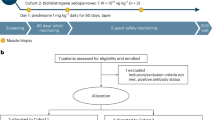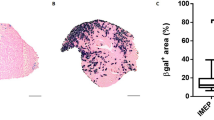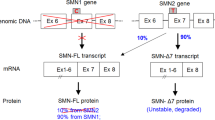Abstract
Limb-girdle muscular dystrophy type 2D (LGMD 2D) is the most common cause of LGMD with a sarcoglycan defect. We recently engineered a murine model for this progressive disease and we investigated the possibility of preventing the development of muscular dystrophy in these animals by adenovirus-mediated gene transfer of human α-sarcoglycan. Here we report that a single intramuscular injection of a first generation adenovirus into the skeletal muscle of neonate mice led to sustained expression of α-sarcoglycan at the sarcolemma of transduced myofibers for at least 7 months. The morphology of transduced muscles was consequently preserved. In addition, we have used contrast agent-enhanced magnetic resonance imaging (MRI) to investigate sarcolemmal integrity in adenovirus-injected animals and have thereby demonstrated maintenance of sarcolemmal function. In conclusion, we provide evidence that early virus-mediated gene transfer of a sarcoglycan protein constitutes a promising therapeutic strategy for LGMDs and that the benefits of this approach can easily and effectively be monitored by noninvasive methodologies such as MRI.
This is a preview of subscription content, access via your institution
Access options
Subscribe to this journal
Receive 12 print issues and online access
$259.00 per year
only $21.58 per issue
Buy this article
- Purchase on Springer Link
- Instant access to full article PDF
Prices may be subject to local taxes which are calculated during checkout






Similar content being viewed by others
References
Ervasti JM, Campbell KP . Membrane organization of the dystrophin–glycoprotein complex Cell 1991 66: 1121–1131
Yoshida M et al. Dissociation of the complex of dystrophin and its associated proteins into several unique groups by n-octyl, β-D-glucoside Eur J Biochem 1994 222: 1055–1061
Crosbie RH et al. Sarcospan: the 25 kDa transmembrane component of the dystrophin–glycoprotein complex J Biol Chem 1997 272: 31221–31224
Crosbie RH et al. Membrane targeting and stabilization of sarcospan is mediated by the sarcoglycan complex J Cell Biol 1999 145: 153–165
Campbell KP, Kahl SD . Association of dystrophin and an integral membrane glycoprotein Nature 1989 338: 259–262
Ervasti JM et al. Deficiency of a glycoprotein component of the dystrophin complex in dystrophic muscle Nature 1990 345: 315–319
Yoshida M, Ozawa E . Glycoprotein complex anchoring dystrophin to the sarcolemma J Biochem (Tokyo) 1990 108: 748–752
Holt KH, Campbell KP . Assembly of the sarcoglycan complex J Biol Chem 1998 273: 34667–34670
Roberds SL et al. Missense mutations in the Adhalin gene linked to autosomal recessive muscular dystrophy Cell 1994 78: 625–633
Bönneman CG et al. β-sarcoglycan mutations cause autosomal recessive muscular dystrophy with loss of the sarcolgycan complex Nat Genet 1995 11: 266–272
Lim LE et al. β-Sarcoglycan: characterization and role in limb-girdle muscular dystrophy linked to 4q12 Nat Genet 1995 11: 257–265
Noguchi S et al. Mutations in the dystrophin-associated protein γ-sarcoglycan in chromosome 13 muscular dystrophy Science 1995 270: 819–822
McNally EM et al. Mutations that disrupt the carboxyl-terminus of γ-sarcoglycan cause muscular dystrophy Hum Mol Genet 1996 5: 1841–1847
Nigro V et al. Identification of a novel sarcoglycan gene at 5q33 encoding a sarcolemmal 35 kDa glycoprotein Hum Mol Genet 1996 5: 1179–1186
Nigro V et al. Autosomal recessive limb-girdle muscular dystrophy, LGMD2F, is caused by a mutation in the δ-sarcoglycan gene Nat Genet 1996 14: 195–198
Bushby KMD . The limb-girdle muscular dystrophies-multiple genes, multiple mechanisms Hum Mol Genet 1999 8: 1875–1882
Lim LE, Campbell KP . The sarcolgycan complex in limb-girdle muscular dystrophy Curr Opin Neurol 1998 11: 443–452
Piccolo F et al. Primary adhalinopathy: a common cause of autosomal recessive muscular dystrophy of variable severity Nat Genet 1995 10: 243–245
Carrié A et al. Mutational diversity and hot spots in the alpha-sarcoglycan gene in autosomal recessive muscular dystrophy (LGMD2D) J Med Genet 1997 34: 470–475
Passos-Bueno MR, Vainzof M, Moreira ES, Zatz M . Seven autosomal recessive limb-girdle muscular dystrophies in the Brazilian population: from LGMD2A to LGMD2G Am J Med Genet 1999 82: 392–398
Holt KH et al. Functional rescue of the sarcoglycan complex in the BIO 14.6 hamster using δ-sarcoglycan gene transfer Mol Cell 1998 1: 841–848
Greelish JP et al. Stable restoration of the sarcoglycan complex in dystrophic muscle perfused with histamine and a recombinant adeno-associated viral vector Nature Med 1999 5: 439–443
Li J et al. rAAV vector-mediated sarcoglycan gene transfer in a hamster model for limb girdle muscular dystrophy Gene Therapy 1999 6: 74–82
Duclos F et al. Progressive muscular dystrophy in alpha-sarcoglycan-deficient mice J Cell Biol 1998 142: 1461–1471
Straub V, Rafael JA, Chamberlain JS, Campbell KP . Animal models for muscular dystrophy show different patterns of sarcolemmal disruption J Cell Biol 1997 139: 375–385
Nalbantoglu J, Pari G, Karpati G, Holland PC . Expression of the primary coxsackie and adenovirus receptor is downregulated during skeletal muscle maturation and limits the efficacy of adenovirus-mediated gene delivery to muscle cells Hum Gene Ther 1999 10: 1009–1019
Yang Y et al. Cellular immunity to viral antigens limits E1-deleted adenoviruses for gene therapy Proc Natl Acad Sci USA 1994 91: 4407–4411
Dai Y et al. Cellular and humoral immune responses to adenoviral vectors containing factor IX gene: tolerization of factor IX and vector antigens allows for long-term expression Proc Natl Acad Sci USA 1995 92: 1401–1405
Jooss K, Ertl HCJ, Wilson JM . Cytotoxic T-lymphocyte target proteins and their major histocompatibility complex class I restriction in response to adenovirus vectors delivered to mouse liver J Virol 1998 72: 2945–2954
Tripathy SK, Black HB, Goldwasser E, Leiden MJ . Immune responses to transgene-encoded proteins limit the stability of gene expression after injection of replication-defective adenovirus vectors Nature Med 1996 2: 545–550
Yang Y, Haecker SE, Su Q, Wilson JM . Immunology of gene therapy with adenoviral vectors in mouse skeletal muscle Hum Mol Genet 1996 5: 1703–1712
Michou A et al. Adenovirus-mediated gene transfer: influence of transgene, mouse strain and type of immune response on persistence of transgene expression Gene Therapy 1997 4: 473–482
Joos K, Yang Y, Fisher KJ, Wilson JM . Transduction of dendritic cells by DNA viral vectors directs the immunre response to transgene products in muscle fibers J Virol 1998 72: 4212–4223
Davis CE, Harris JB, Nicholson LVB . Myosin isoform transitions and physiological properties of regenerated and re-innervated sole muscles of the rat Neuromusc Disord 1991 1: 411–421
Straub V et al. Contrast agent-enhanced magnetic resonance imaging of skeletal muscle damage in animal models of muscular dystrophy Magn Reson Med (in press)
Fechner H et al. Expression of Coxsackie adenovirus receptor and alphav-integrin does not correlate with adenovector targeting in vivo indicating anatomical vector barriers Gene Therapy 1999 6: 1520–1535
Amalfitano A . Next-generation adenoviral vectors: new and improved Gene Therapy 1999 6: 1643–1645
Ohlendieck K, Campbell KP . Dystrophin-associated proteins are greatly reduced in skeletal muscle from mdx mice J Cell Biol 1991 115: 1685–1694
Durbeej M et al. Disruption of the β-sarcoglycan gene reveals pathogenetic complexity of limb-girdle muscular dystrophy type 2E Mol Cell 2000 5: 141–151
Chen HH et al. Persistence in muscle of an adenoviral vector that lacks all viral genes Proc Natl Acad Sci USA 1997 94: 1645–1650
Acknowledgements
We are indebted to Dr Franck Duclos for generating the Sgca-null mice. We gratefully acknowledge Richard D Anderson and the Gene Therapy Center Vector Core Facility, DK54759 for their support. We thank EPIX Medical/Mallinckrodt Inc. for supplying the contrast agent AngioMark (MS-325) used in this study. We thank members of the Campbell laboratory for fruitful discussions and critical reading of this manuscript. VA is the recipient of a Neuromuscular Disease Research Development Grant from the Muscular Dystrophy Association. VS was supported by a grant from the Deutsche Forschungsgemeinschaft (Str 498/1-1). KMD was supported by The Whitaker Foundation. This work is also funded by a grant from the Muscular Dystrophy Association to KPC. BLD is a fellow of the Roy J Carver Trust. KPC is an Investigator of the Howard Hughes Medical Institute.
Author information
Authors and Affiliations
Rights and permissions
About this article
Cite this article
Allamand, V., Donahue, K., Straub, V. et al. Early adenovirus-mediated gene transfer effectively prevents muscular dystrophy in alpha-sarcoglycan-deficient mice. Gene Ther 7, 1385–1391 (2000). https://doi.org/10.1038/sj.gt.3301247
Received:
Accepted:
Published:
Issue Date:
DOI: https://doi.org/10.1038/sj.gt.3301247
Keywords
This article is cited by
-
Phenotypic Correction of α-Sarcoglycan Deficiency by Intra-arterial Injection of a Muscle-specific Serotype 1 rAAV Vector
Molecular Therapy (2007)
-
Long-term Skeletal Muscle Protection After Gene Transfer in a Mouse Model of LGMD-2D
Molecular Therapy (2007)
-
Modulating mtDNA heteroplasmy by mitochondria-targeted restriction endonucleases in a ‘differential multiple cleavage-site’ model
Gene Therapy (2007)
-
In vivo NMR imaging evaluation of efficiency and toxicity of gene electrotransfer in rat muscle
Gene Therapy (2005)



